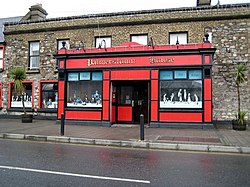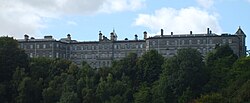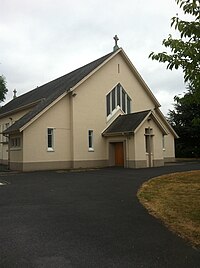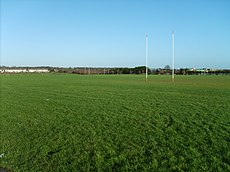Palmerstown: Difference between revisions
Created page with "{{Infobox town |name=Palmerstown |irish=Baile Phámar |county=Dublin |picture=Palmerstown House, Palmerstown - geograph.org.uk - 738809.jpg |picture caption=Palmerstown House,..." |
mNo edit summary |
||
| Line 10: | Line 10: | ||
|census year=2016 | |census year=2016 | ||
|population=11,130 | |population=11,130 | ||
|post town=Dublin | |||
|postcode=D20 | |||
|LG district=South Dublin | |LG district=South Dublin | ||
|constituency=Dublin Mid-West | |constituency=Dublin Mid-West | ||
| Line 18: | Line 20: | ||
==Name== | ==Name== | ||
Between 1185 and 1188, Ailred the Palmer and his wife (a 'palmer' being a mediæval term for a pilgrim) took religious vows and founded a priory and monastic hospital of Crutched Friars outside the West Gate of Dublin, on the road to [[Kilmainham]], which they endowed with all their property.<ref name=h88>{{cite book|editor-last1=Smyth|editor-first1=William J. |editor-last2=Whelan|editor-first2=Kevin |first=Mark |last=Hennessy|title=Common Ground: Essays on the Historical Geography of Ireland : Presented to T. Jones Hughes|year=1988|publisher=Cork University Press|pages=41–54 : 42–43 |chapter=The priory and hospital of New Gate: the evolution and decline of a mediæval monastic estate}}</ref> In 1188 Pope Clement III confirmed the priory's grants, including the both the parish of Palmerstown west of Kilmainham and another parish named Palmerstown, in the north of the county.<ref name=h88/> Gerard Lee notes an association of palmers with leper hospitals, of which there was one dedicated to St Laurence in the townland of the same name in Palmerstown.<ref name=l67>{{cite journal|last=Lee|first=Gerard A.|date=June 1967|title=Leprosy and certain Irish placenames|journal=Dinnseanchas|volume=2|issue=3|pages=71–72|url=https://www.logainm.ie/Eolas/Data/Brainse/dinnseanchas-2-1966-1967.pdf#page=40| | Between 1185 and 1188, Ailred the Palmer and his wife (a 'palmer' being a mediæval term for a pilgrim) took religious vows and founded a priory and monastic hospital of Crutched Friars outside the West Gate of Dublin, on the road to [[Kilmainham]], which they endowed with all their property.<ref name=h88>{{cite book|editor-last1=Smyth|editor-first1=William J. |editor-last2=Whelan|editor-first2=Kevin |first=Mark |last=Hennessy|title=Common Ground: Essays on the Historical Geography of Ireland : Presented to T. Jones Hughes|year=1988|publisher=Cork University Press|pages=41–54 : 42–43 |chapter=The priory and hospital of New Gate: the evolution and decline of a mediæval monastic estate}}</ref> In 1188 Pope Clement III confirmed the priory's grants, including the both the parish of Palmerstown west of Kilmainham and another parish named Palmerstown, in the north of the county.<ref name=h88/> Gerard Lee notes an association of palmers with leper hospitals, of which there was one dedicated to St Laurence in the townland of the same name in Palmerstown.<ref name=l67>{{cite journal|last=Lee|first=Gerard A.|date=June 1967|title=Leprosy and certain Irish placenames|journal=Dinnseanchas|volume=2|issue=3|pages=71–72|url=https://www.logainm.ie/Eolas/Data/Brainse/dinnseanchas-2-1966-1967.pdf#page=40|accessdate=7 November 2014}}</ref><ref>{{cite web|url=http://www.logainm.ie/en/57055|title=Saintlaurence|work=Placenames Database of Ireland|quote=This place appears to have taken its name from a leprosy hospital dedicated to the martyr Saint Laurence.|accessdate=7 November 2014}}</ref> | ||
The spelling "Palmerston" rather than "Palmerstown" was fixed by the Ordnance Survey of Ireland in the 1830s; this remains the recognised, legal spelling. Locals however generally use "Palmerstown". Road signs have used both. (In 2009 a plebiscite to change the official name to "Palmerstown" was narrowly defeated.<ref name=h12>[http://www.herald.ie/news/council-faces-a-70k-bill-for-second-vote-in-name-row-over-palmerstown-29830212.html Council faces a €70k bill for second vote in name row over Palmersto(w)n]</ref> | The spelling "Palmerston" rather than "Palmerstown" was fixed by the Ordnance Survey of Ireland in the 1830s; this remains the recognised, legal spelling. Locals however generally use "Palmerstown". Road signs have used both. (In 2009 a plebiscite to change the official name to "Palmerstown" was narrowly defeated.<ref name=h12>[http://www.herald.ie/news/council-faces-a-70k-bill-for-second-vote-in-name-row-over-palmerstown-29830212.html Council faces a €70k bill for second vote in name row over Palmersto(w)n]</ref> | ||
The title Viscount Palmerston created in 1722 in the Peerage of Ireland derives from the place;<ref>{{cite book|title=The Parliamentary Gazetteer of Ireland: Adapted to the New Poor-law, Franchise, Municipal and Ecclesiastical Arrangements, and Compiled with a Special Reference to the Lines of Railroad and Canal Communication, as Existing in 1844–45|url=https://books.google.com/books?id=1HMuAAAAMAAJ&pg=PA68| | The title Viscount Palmerston created in 1722 in the Peerage of Ireland derives from the place;<ref>{{cite book|title=The Parliamentary Gazetteer of Ireland: Adapted to the New Poor-law, Franchise, Municipal and Ecclesiastical Arrangements, and Compiled with a Special Reference to the Lines of Railroad and Canal Communication, as Existing in 1844–45|url=https://books.google.com/books?id=1HMuAAAAMAAJ&pg=PA68|accessdate=7 November 2014|volume=III: N-Z|year=1846|publisher=A. Fullarton and Company|page=68|chapter=Palmerstown}}</ref> its spelling also varied,<ref>{{cite book|last=O'Hart|first=John |author-link=John O'Hart|title=Irish pedigrees; or, The origin and stem of the Irish nation|url=https://archive.org/stream/cu31924092516297#page/n317/mode/2up|year=1880|publisher=Gill|location=Dublin|page=286|quote=The Temples, viscounts Palmerstown or Palmerston. }}</ref> but the form "Lord Palmerston" is now usual for the Victorian prime minister.<ref>{{cite web|url=http://id.loc.gov/authorities/names/n81019980.html|title=Palmerston, Henry John Temple, Viscount, 1784-1865 |work=Library of Congress Control Number|LC Linked Data Service |publisher=Library of Congress|accessdate=7 November 2014}}</ref> | ||
==About the village== | ==About the village== | ||
Latest revision as of 10:53, 8 March 2021
| Palmerstown Irish: Baile Phámar | |
| County Dublin | |
|---|---|
 Palmerstown House, Palmerstown | |
| Location | |
| Grid reference: | O082345 |
| Location: | 53°21’0"N, 6°22’44"W |
| Data | |
| Population: | 11,130 (2016) |
| Post town: | Dublin |
| Postcode: | D20 |
| Local Government | |
| Council: | South Dublin |
| Dáil constituency: |
Dublin Mid-West |
Palmerstown, also known as Palmerston, is a village in the west of County Dublin on the banks of the River Liffey. The area is bordered to the north by the River Liffey, to the west by Lucan, to the south-west by Clondalkin, to the south by Ballyfermot and to the east by the village of Chapelizod.
Palmerstown village is near the Liffey Valley Shopping Centre. The area is situated near the major junction of the M50 motorway and the N4. It lies approximately four miles west of O'Connell Street in Dublin city centre. The Old Lucan Road, once the main route from the city to the west, passes through the centre of Palmerstown village.
Name
Between 1185 and 1188, Ailred the Palmer and his wife (a 'palmer' being a mediæval term for a pilgrim) took religious vows and founded a priory and monastic hospital of Crutched Friars outside the West Gate of Dublin, on the road to Kilmainham, which they endowed with all their property.[1] In 1188 Pope Clement III confirmed the priory's grants, including the both the parish of Palmerstown west of Kilmainham and another parish named Palmerstown, in the north of the county.[1] Gerard Lee notes an association of palmers with leper hospitals, of which there was one dedicated to St Laurence in the townland of the same name in Palmerstown.[2][3]
The spelling "Palmerston" rather than "Palmerstown" was fixed by the Ordnance Survey of Ireland in the 1830s; this remains the recognised, legal spelling. Locals however generally use "Palmerstown". Road signs have used both. (In 2009 a plebiscite to change the official name to "Palmerstown" was narrowly defeated.[4]
The title Viscount Palmerston created in 1722 in the Peerage of Ireland derives from the place;[5] its spelling also varied,[6] but the form "Lord Palmerston" is now usual for the Victorian prime minister.[7]
About the village
Palmerstown village


The townlands of Palmerstown Upper and Palmerstown Lower straddle the old Lucan Road which was the ancient western highway. Many of Palmerstown's local amenities are located in a cluster along the road. Robin Villas and Hollyville were labourers' cottages built at the beginning of the last century. The old national school is now a community centre. Stewarts Hospital, (formerly the residence of the Hely-Hutchinson family, the Roman Catholic Church of St. Philomena, the National School, the Palmerstown House Pub and Restaurant and a variety of general enterprises, including a bank and convenience stores are located here. Stewartscare is a health care facility at the Stewarts buildings and grounds which overlook the meandering Liffey valley. The Stewarts complex houses the administration of the Irish Health Service Executive. Stewarts Sports and Leisure centre is open to the general public. It also hosts an annual summer camp.
Redcow Farm

Redcow Farm was the location of the first modern housing development in Palmerstown, constructed between 1955 and 1965. Centred on Manor road, this area contains several shops, the local credit union and a doctor's surgery.
To the east of Redcow Farm, adjacent to the California Hills Park. The name 'California Hill' was given, by the children of the area, to a small wasteland in Ballyfermot to the East of Glenaulin Park, which had been a builder's dump during the construction of the main Palmerstown Estate in the mid to late 60's. The wasteland had a series of small hills which were in fact mounds of builders rubble which had been buried under clay and eventually over grown with wild grass. The children of the area sometimes shortened the name to 'The Caliers' and this name is also still in use today. The hills or mounds were flattened some years ago and the area landscaped for communal/public use.
Palmerston Lower
Mill Lane leads to the original Palmerstown settlement and centre of industry, which once employed over 600 millhands, craftsmen, and labourers. This seventeenth-century low-lying waterside industrial village was complete with flax, seed, oil, and flour mills. The ruin of a pre-Norman church and the remains of the once prosperous thriving community are situated near the river. A small ferry crossed the Liffey here, to where the Wren's Nest pub was situated on the North side.
Palmerstown Manor
Palmerstown's largest housing estate was built in the early 1990s in the south east of the area. Adjacent to the Coldcut and Kennelsfort roads and the M50 motorway, the estate marks the 'border' between Palmerstown with Ballyfermot and Clondalkin.
Woodfarm Acres
The townland of Woodfarm Acres was mostly farmland, with a few council cottages previously existed on the site. This housing development was built during the 1970s. The estate is bounded by the M50 motorway and N4. Adjacent to Woodfarm Acres is another shopping centre. The Silver Granite Pub is located nearby, as is Pobalscoil Isolde, a secondary-level community school which opened in the 1980s.
Oakcourt
The Oakcourt housing estate lies in the western part of the 59-acre Johnstown townland, behind Pobalscoil Iosolde. It was originally developed in the 1970s, and expanded in the mid-1990s. The Johnstown townland extends due west from the Georgian Johnstown House (now St. John's College) on Le Fanu Rd. It runs west to Kennelsfort Road and lies between St. Laurence townland (the St. Laurence House is now the West County Hotel) from the River Liffey and Chapelizod in the north, to Ballyfermot Upper/Blackditch on the south.
Outside links
- South Dublin County History
- South Dublin County Images
- St Patricks GAA Hurling, Football and Camogie Club
References
- ↑ 1.0 1.1 Hennessy, Mark (1988). "The priory and hospital of New Gate: the evolution and decline of a mediæval monastic estate". Common Ground: Essays on the Historical Geography of Ireland : Presented to T. Jones Hughes. Cork University Press. pp. 41–54 : 42–43.
- ↑ Lee, Gerard A. (June 1967). "Leprosy and certain Irish placenames". Dinnseanchas 2 (3): 71–72. https://www.logainm.ie/Eolas/Data/Brainse/dinnseanchas-2-1966-1967.pdf#page=40. Retrieved 7 November 2014.
- ↑ "Saintlaurence". Placenames Database of Ireland. http://www.logainm.ie/en/57055. Retrieved 7 November 2014. "This place appears to have taken its name from a leprosy hospital dedicated to the martyr Saint Laurence."
- ↑ Council faces a €70k bill for second vote in name row over Palmersto(w)n
- ↑ "Palmerstown". The Parliamentary Gazetteer of Ireland: Adapted to the New Poor-law, Franchise, Municipal and Ecclesiastical Arrangements, and Compiled with a Special Reference to the Lines of Railroad and Canal Communication, as Existing in 1844–45. III: N-Z. A. Fullarton and Company. 1846. p. 68. https://books.google.com/books?id=1HMuAAAAMAAJ&pg=PA68. Retrieved 7 November 2014.
- ↑ O'Hart, John (1880). Irish pedigrees; or, The origin and stem of the Irish nation. Dublin: Gill. p. 286. https://archive.org/stream/cu31924092516297#page/n317/mode/2up. "The Temples, viscounts Palmerstown or Palmerston."
- ↑ "Palmerston, Henry John Temple, Viscount, 1784-1865". Library of Congress Control Number. Library of Congress. http://id.loc.gov/authorities/names/n81019980.html. Retrieved 7 November 2014.